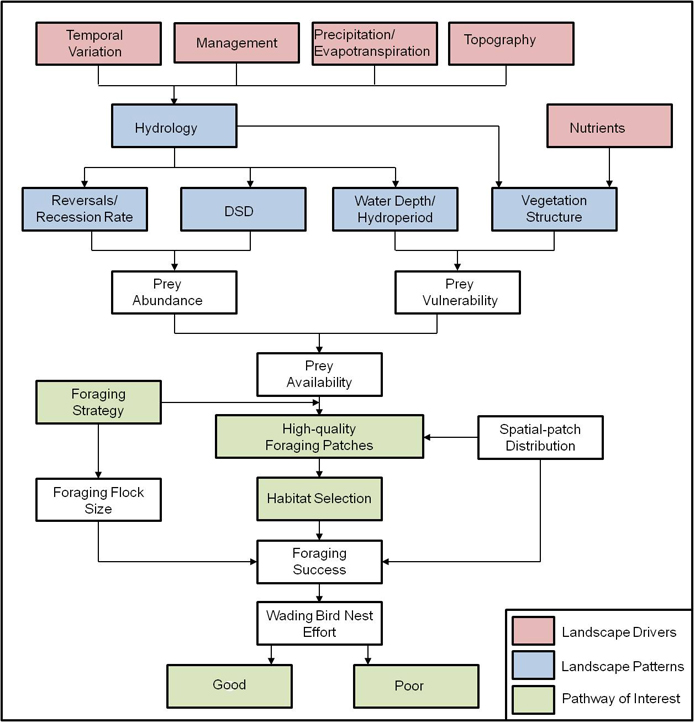Introduction

Once a vast ecosystem stretching over 1 million hectares, the current Everglades is half its original size; what remains has altered physical driving forces with significant changes to its wading bird populations. Wading birds have been used as indicators of the health and function of the Everglades ecosystem due to a key hypothesis underlying its restoration effort, the "trophic hypothesis", which states that hydrologic patterns, fish populations, and wading birds are linked (RECOVER 2004). A combination of field studies (Kahl 1964, Kushlan 1976), experiments (Gawlik 2002, Cook and Herring 2007, Herring et al. 2010) and modeling (Fleming et al. 1994) have demonstrated segments of this linkage (RECOVER 2004). It is imperative to quantify these relationships in order to restore natural hydrologic patterns and, ultimately, wading birds.

Wading bird nests numbers in the Everglades have decreased by 70% since the 1930s; however, population trends are species specific (Crozier and Gawlik 2003). Since the 1930s, the number of Wood Stork (Myctera americana) nests have declined by 78%, and the number of White Ibis (Eudocimus albus) nests have declined 87%; however, the number of Great Egret nests (Ardea alba) have increased at least 270% (Crozier and Gawlik 2003). Clearly, management solutions designed to reverse these declines must take into account differences in species responses.
Declines in wading bird numbers have been linked to changes of the historic hydropattern of the Everglades ecosystem (Ogden 1994). Historically, water flowed virtually uninterrupted from the Kissimmee River through Lake Okeechobee, into the Everglades over a low gradient landscape, and discharged into the Gulf of Mexico and Florida Bay. The sheet flow of water across the landscape was shallow and slow-moving, creating a mosaic of ponds, sloughs, sawgrass ridges, hardwood hammocks and forested uplands (Perry 2004). Pre-disturbance water storage in the system was dynamic and spatially variable (DeAngelis 1994). During the dry season water receded across the landscape creating a transitional ecotone that concentrated aquatic prey into spatially isolated pools. This concentration of aquatic prey provides ideal foraging habitat for large flocks of wading birds (Bancroft 1989, Ogden 1994).

Increases in the human population during the 20th Century in South Florida amplified water management needs. Extensive drainage canals and water-control structures were built to manage floods as well as to provide water to South Florida residents, reducing available water for the ecosystem by over 70% (Perry 2004) and altering the natural sheet flow, recession rate, and water depths. Moreover, increases in land conversion for agricultural uses in the northern Everglades increased nutrient inputs into the system. Collectively, the altered hydrologic and nutrient patterns are believed to have modified the spatial and temporal availability of wading bird prey throughout the breeding season, thus leading to the observed nesting trends (Frederick and Spalding 1994, Ogden 1994, Gawlik 2002).
Objectives
- Develop a foraging habitat use model for Great Egret, White Ibis and Wood Stork to determine the spatial and temporal dynamics of habitat selection by foraging wading birds in the Everglades.
- Develop Great Egret, White Ibis, and Wood Stork nest effort models to determine spatial and temporal patterns that predict the success of the nesting season and examine hydrologic and habitat characteristics which produce years of high nest effort.
Figure 1. Conceptual model of how landscape level processes affect wading bird habitat selection.

Figure 2. Conceptual model outlining hypotheses for factors affecting wading bird nest effort in the Everglades. Hypotheses are delineated by solid or dashed grey and black lines.

